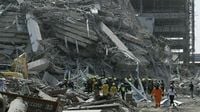On March 28, 2025, Thailand's Prime Minister Paetongtarn Shinawatra declared a state of emergency for Bangkok following a devastating earthquake that struck the region. The Prime Minister had to cut short a trip abroad to convene an emergency government meeting to address the crisis.
Initial reports indicated that no casualties were reported within Thailand. However, the situation took a dire turn when a 30-story building under construction collapsed, prompting immediate rescue operations. Emergency workers began searching through the rubble of concrete and steel for construction workers who might be trapped beneath the debris.
The earthquake that triggered this disaster registered a magnitude of 7.7, according to the United States Geological Survey (USGS), with its epicenter located in Myanmar. The tremors from this powerful quake were felt as far away as China, highlighting the earthquake's significant impact across national borders. Just minutes after the first quake, a second earthquake with a magnitude of 6.4 occurred, adding to the uncertainty and fear in the region.
Florian Bahrdt from ARD Singapore reported on the ongoing situation, noting the heightened state of alert and the urgency of the rescue efforts. As the scene unfolded, local authorities and rescue teams worked tirelessly to locate and assist those who may have been affected by the building's collapse.
The declaration of a state of emergency by Prime Minister Shinawatra underlines the seriousness of the situation. It allows for the mobilization of additional resources and the implementation of safety measures to protect the citizens of Bangkok during this critical time.
As rescue operations continue, the focus remains on ensuring the safety of those affected and providing necessary support to the families of construction workers who may be unaccounted for. The Thai government has urged citizens to remain calm and to follow safety protocols as aftershocks may continue.
This earthquake serves as a reminder of the geological volatility of Southeast Asia, a region that has experienced its share of natural disasters. Authorities are expected to conduct thorough assessments of building codes and safety regulations in the wake of this incident to prevent such tragedies in the future.
In the hours following the earthquake, social media has been flooded with messages of support and solidarity from both local residents and international observers. Many have expressed their concern for those affected and have called for immediate assistance to aid in recovery efforts.
The Thai government is likely to face scrutiny regarding the safety of construction practices in the country, especially given the collapse of a major structure. Questions surrounding the building's integrity and adherence to safety standards will undoubtedly arise as investigations begin.
As the situation develops, it is crucial for the government to communicate effectively with the public, providing updates on rescue efforts and safety information. Transparency will be key in maintaining public trust during this challenging time.
In summary, the earthquake that struck Southeast Asia on March 28, 2025, has led to a state of emergency in Bangkok, with ongoing rescue operations for construction workers trapped under a collapsed building. The region remains on high alert for potential aftershocks, and authorities are working diligently to ensure the safety and well-being of affected individuals.





